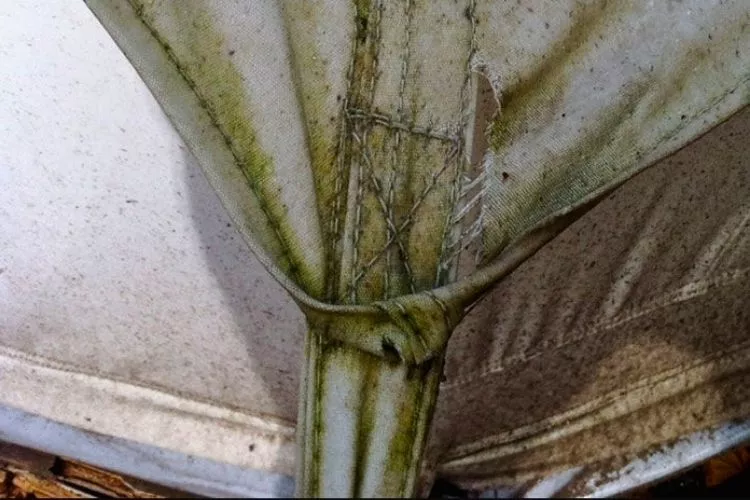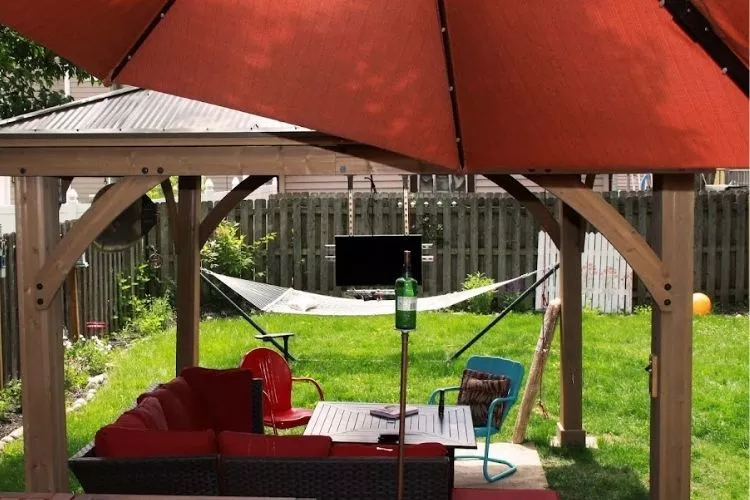There’s nothing like the charm of a well-maintained gazebo in your backyard, a place of relaxation and retreat. But, if mold begins to creep up its beams and pillars, not only does it mar the gazebo’s beauty, it also poses a silent threat.
So it’s important to master the knowledge of how to clean mold off a gazebo as easily as possible.
Mold isn’t just unsightly; it’s a health hazard. Breathing in mold spores can lead to respiratory issues, allergic reactions, and other health complications.
I understand the unease and frustration this might bring you. Maybe you’ve tried cleaning it, only to see it return, or perhaps you’re clueless about where to start. Either way, this guide is here to help.
We’ll delve into the heart of the mold issue, break down its dangers, and most importantly, lay out a step-by-step process to reclaim your gazebo’s pristine state. Stick around, and let’s restore that gazebo together!

Understanding Mold
Before we dive into the cleaning, let’s unpack this sneaky intruder. Ever wonder what mold really is? Let’s get into the nitty-gritty.
What is mold?
Mold is like that uninvited guest that crashes your party. It’s a type of fungus, made up of tiny organisms found almost everywhere. They come in a rainbow of colors – black, white, orange, green, and more. When conditions are just right, with moisture and warmth, they reproduce and spread, turning that once beautiful gazebo corner into a discolored mess.
Common types of mold found on gazebos
Now, here’s a surprise. Your gazebo might host a variety of mold types. Some of the common culprits include Cladosporium (often appearing black or green), Penicillium (yes, where the antibiotic comes from, often seen as blue or green), and Alternaria (a speedy spreader and common allergen). Each of them loves the great outdoors, especially when there’s a bit of dampness in the air.
Signs of mold infestation on a gazebo
“But how do I know it’s mold and not just dirt?” Great question! Mold often starts as a small, fuzzy patch, but then it can sprawl out. It might also have a musty smell. If your gazebo wood feels softer than usual or you notice discoloration that’s spreading, you might just have a mold situation on your hands.
Safety Precautions
Alright, before we roll up our sleeves and get down to the dirty work, let’s chat safety. You wouldn’t go into battle without armor, right? Tackling mold is no different. Protecting yourself is paramount, especially when dealing with something that has potential health implications.

Necessary safety equipment
Before diving into the specifics, let’s lay out the essentials. Think of these items as your mold-fighting toolkit. They’re going to ensure that not only do you eradicate mold efficiently, but you do so without any harm to yourself. Let’s gear up!
- Respiratory mask: First things first, we’re talking about the air you breathe. Mold spores are tiny; they love to float around and can be easily inhaled. A good quality respiratory mask (preferably an N95 mask) is non-negotiable. This isn’t just about avoiding that musty smell; it’s about keeping those pesky spores out of your lungs.
- Gloves: Next on the list? Gloves. These are crucial. You don’t want to be touching mold directly, and certainly not with bare hands. Opt for durable, non-latex gloves that give you a good grip but also act as a protective barrier.
- Eye protection: You might be wondering, “Do I really need eye protection?” Trust me, you do. Mold can release irritants, and you’d be surprised how a simple scrub can send particles flying. Safety goggles will protect your eyes from any unexpected splashes or airborne spores.
Ventilation considerations
This is especially crucial if you’re dealing with a covered or enclosed gazebo. While you’re cleaning, you want to ensure there’s a consistent airflow. Not only does this help disperse the mold spores, but it aids in drying the gazebo afterward. If possible, choose a breezy day for your cleaning escapade or even consider using fans to assist in ventilation.
How to safely handle moldy materials?
Let’s say you’ve got mold-infested cushions or fabrics in your gazebo. Don’t just tug them out without a plan. Place them in a thick plastic bag while still inside the gazebo, seal it tight, and only then dispose of them.
This way, you’re not giving the mold a chance to spread to other areas. Also, once you’re done cleaning, remember to wash your clothes immediately.
Cleaning Supplies
So, you’ve got your safety gear on point. Now, let’s assemble our cleaning arsenal. The right tools and solutions can make a world of difference, turning an arduous task into something much more manageable. Let’s explore the key players.

Essential cleaning materials
Before we get into the nitty-gritty, here’s a brief snapshot of the heavy hitters in our cleaning lineup. Each of these plays a crucial role in ensuring that mold meets its match.
- Bleach: Ah, bleach. It’s the superhero of mold removal. This potent solution eradicates mold at the root, ensuring it doesn’t just disappear, but stays gone. Remember, though, its strength is also its drawback. Use it in a well-ventilated area and always dilute before application.
- Water: Water plays a dual role. It’s essential for diluting bleach to the right concentration, and it’s also your primary tool for rinsing away the remnants of your mold-fighting efforts. Clean, fresh water ensures that the gazebo surface is prepped and pristine post-cleaning.
- Scrub brush: A sturdy scrub brush is like your sword in this battle against mold. Its bristles dig deep, ensuring that no mold patch is left untouched. Choose a brush with stiff bristles – it’ll help in dislodging even the most stubborn of mold patches.
- Bucket: Last but definitely not least, the humble bucket. This will be your main container for your cleaning solution. It’s also handy for rinsing and fetching fresh water as you go. Go for a good-sized one so you’re not constantly refilling.
Alternatives to bleach for eco-friendly cleaning
Alright, I hear you. Not everyone is on team bleach, and I totally get it. Whether you’re environmentally conscious or just not a fan of strong chemicals, there are greener ways to combat mold. And guess what? They can be just as effective without giving Mother Nature a headache.
- White Vinegar: A household staple, white vinegar is mildly acidic, making it an excellent mold assassin. Simply put it in a spray bottle, undiluted, spray onto the mold, let it sit for an hour, and then rinse.
- Baking Soda: Not just for baking! Mix it with water to form a paste, apply to the moldy area, scrub, and rinse. It’s gentle, non-toxic, and also acts as a deodorizer, tackling that musty mold smell.
- Hydrogen Peroxide: This is a fantastic antifungal, antiviral, and antibacterial solution. Use a 3% solution in a spray bottle, let it sit on the mold for about ten minutes, scrub, and then wipe clean.
- Tea Tree Oil: A bit on the pricier side, but super effective. Mix two teaspoons of tea tree oil with two cups of water, spray onto mold, don’t rinse. The strong scent will dissipate, leaving you with a mold-free gazebo.
- Grapefruit Seed Extract: Like tea tree oil, this isn’t the cheapest option, but it’s a powerful, natural mold killer. Mix about ten drops with a cup of water, spray on mold, and leave it be. No need to rinse.
Going green doesn’t mean compromising on efficacy. With these alternatives, you’re not only giving mold the boot but doing so in an earth-friendly manner. High fives to that!
Preparing the Work Area
Alright, before we roll up our sleeves and dive into the cleaning process, let’s set the stage. A well-prepared workspace isn’t just about efficiency; it’s also about safety and ensuring that everything goes off without a hitch.
So, let’s get our gazebo ready for its spa day, shall we?

- Removing furniture and decor: First things first. Let’s clear the deck! Remove all furniture, cushions, hanging lanterns, or any decor items. Not only does this give you unobstructed access to all those sneaky mold spots, but it also ensures your furniture remains undamaged by the cleaning agents.
- Covering nearby plants and landscaping: You love your plants, and so do I. If your gazebo is surrounded by lovely shrubs, flowers, or even a manicured lawn, take a moment to cover them with tarps or plastic sheets. This prevents any cleaning solutions, even the eco-friendly ones, from potentially harming them.
- Setting up a safe workspace: Ventilation is key, especially if you’re using bleach or other potent cleaners. Ensure there’s good airflow, which helps disperse fumes and speeds up drying. Lay down a tarp or old sheets beneath the gazebo to catch runoff. This not only protects the ground but makes the cleanup process a breeze.
How to Clean Mold Off a Gazebo? (A Step By Step Guide)
Alright, my friend, this is where the rubber meets the road. We’ve prepped, we’ve planned, and now it’s time to tackle that pesky mold head-on. I promise, with the right steps and a bit of elbow grease, your gazebo will be looking brand new in no time. Ready to get started? Let’s dive in!

Preliminary steps
Before we truly dive into the thick of it, we’ve got some groundwork to lay. It’s a bit like cooking; gathering and prepping all our ingredients before we fire up the stove. Trust me, these initial steps will make the entire cleaning process smoother and more effective. Here’s what you’ve got to do:
Inspect the gazebo
Alright, this may sound basic, but we’re starting with a thorough inspection. Grab a flashlight if needed and scrutinize every nook and cranny. Look under seating areas, between floorboards, and even the roof. It’s essential to know what you’re dealing with. Like mapping out a treasure hunt, pinpointing every moldy spot helps plan your cleaning attack.
Identify the extent of mold growth
Now that we’ve spotted our unwanted “guests,” it’s time to gauge the severity. Is it just a small patch here and there, or are we dealing with a full-blown invasion? Identifying the extent of the mold growth will determine how much cleaning solution you’ll need and the effort required. Remember, it’s not about scaring you; it’s about being prepared.
Mix the cleaning solution
With our gazebo mapped out, it’s time to whip up our magic cleaning potion. Depending on your choice of cleaning agent, be it the mighty bleach or the gentler eco-friendly alternatives, the mixing process might vary. But don’t fret, I’ve got your back. Let’s break it down:
Proper bleach dilution
Now, if you’re leaning towards bleach, remember: concentration is key. Too strong, and you might harm the gazebo’s material; too weak, and you’re just giving the mold a nice bath. Generally, a good rule of thumb is 1 cup of bleach for every 1 gallon of water (that’s roughly 240 ml of bleach for every 3.8 liters). This concoction will be potent enough to annihilate mold and gentle enough to preserve the integrity of your beloved gazebo.
Using eco-friendly alternatives
For those of you riding the green wave (kudos, by the way!), you’ve got options. White vinegar can be used straight from the bottle, while a baking soda solution would require about a quarter of a tablespoon mixed with water in a spray bottle. If you’re opting for hydrogen peroxide, a 3% solution works wonders, as we discussed earlier. Remember, nature’s got your back, and these solutions can be just as mighty against mold.
Applying the cleaning solution
Now that we’ve got our trusty cleaning solution mixed and ready, it’s go-time! Proper application can make the difference between a mildly clean gazebo and one that gleams like the day you first laid eyes on it. Let’s make sure every drop counts.
Soaking affected areas
Let’s face it, mold is stubborn. You can’t just swipe it away with a quick pass. First, generously apply your cleaning solution to the moldy areas. Using a spray bottle can be a game-changer here – it ensures even distribution. Once you’ve drenched the mold, let it sit. This soaking period is crucial.
Think of it as the cleaning solution doing the heavy lifting for you, breaking down the mold’s defenses. Allow it to soak for at least 10 to 15 minutes (or up to an hour for particularly stubborn patches). This waiting period might seem endless, but it’s worth every tick of the clock.
Scrubbing the surface
After our soak-time, arm yourself with a scrub brush (or an old toothbrush for tight spots) and get to work. Use firm, circular motions to scrub away the mold. You’ll literally see it lifting off. If there are areas where the mold seems especially persistent, feel free to reapply the solution and scrub again.
It’s therapeutic, right? There’s something oddly satisfying about seeing the mold vanish with each brush stroke. Remember to frequently rinse your brush to ensure you’re not just spreading the mold around.
Rinse and repeat
Ah, the age-old mantra: “rinse and repeat.” It’s a staple for a reason, especially when battling mold. After a deep cleanse, the gazebo needs a thorough rinse to wash away the remnants of both mold and our potent cleaning solutions. Let’s get that gazebo looking and feeling fresh:
Rinsing off the bleach
If you’ve gone down the bleach route, this step is doubly essential. Bleach residue can discolor surfaces and harm plants if left to sit too long. So, take your garden hose or a bucket of clean water and rinse every inch of the treated area. Ensure a thorough wash, clearing away all bleach traces.
If you’ve got a detachable showerhead or a pressure washer on a low setting, even better! They help in making sure no sneaky bleach pockets remain. Once done, pat yourself on the back; the bleach served its purpose and is now safely washed away.
Repeating the process as needed
While we’d all love a one-and-done solution, mold can sometimes be more resilient. So, if you spot any areas that still have mold or if it returns after a few days, don’t be disheartened. Just gear up and repeat the process. With each cycle, the mold gets weaker, and your gazebo gets closer to its pristine state. Remember, persistence is key. Mold may be stubborn, but you’re more determined.
Drying the gazebo
We’re almost at the finish line! With our gazebo now free of mold, it’s crucial to ensure it’s thoroughly dry. A moist environment can invite mold right back in, and we definitely don’t want a repeat performance. So let’s dive into the final act: drying.
Sun-drying vs. air-drying
You might wonder: “Should I let the sun do its magic or just trust the breeze?” Well, both have their merits!
- Sun-drying: Good ol’ sunshine is nature’s best dryer. The sun’s ultraviolet rays can also act as a natural disinfectant, helping to kill any lingering mold spores. If your gazebo is in a spot that receives ample sunlight, let it bathe in the warm rays. This method not only dries but further sanitizes the area. Just remember, too much direct sunlight might fade some materials over time, so don’t overdo it.
- Air-drying: If your gazebo is tucked in a shady spot or it’s a cloudy day, air-drying is the way to go. While it might take a tad longer, the open-air does a fantastic job. To speed up the process, consider setting up fans around the gazebo to circulate air and expedite the drying. The gentle hum of the fans, the freshness of the space— it’s all a sign of a job well done.
Regardless of the method you choose, ensure the gazebo is bone dry before setting any furniture or decor back. It seals the deal, ensuring mold doesn’t have the welcoming environment it craves.
Preventing Future Mold Growth
Whew, the hard work is done! Your gazebo should now be spick and span. But, as the age-old adage goes, “prevention is better than cure.” Now, let’s ensure that pesky mold doesn’t even think about making a comeback. Here’s how to keep your gazebo mold-free in the long run.

Regular maintenance
It all starts with consistency. By performing routine checks and cleanings, you’re essentially cutting mold off before it can establish a stronghold. Wipe down surfaces with mild, eco-friendly cleaners once a month, and after heavy rainfalls or humid spells. Additionally, make it a point to inspect the nooks and crannies where moisture could hide.
Improving ventilation
Mold loves stagnant, humid environments. Combat this by ensuring good airflow throughout your gazebo. Adding vents or mesh screens, or simply keeping the sides open more often, can significantly increase ventilation. Encouraging cross-ventilation by ensuring there are multiple entry and exit points for the air is another smart move.
Using mold-resistant materials
If you’re building a new gazebo or renovating, consider investing in mold-resistant materials. From treated woods to special paints, numerous products resist mold growth. Not only do they provide peace of mind, but they also add longevity to your gazebo’s life.
Pro Tips
Ah, the joys of a clean gazebo! But as with many tasks in life, there’s always a hack or two to make things a tad easier. Through my years of battle against the relentless mold, I’ve picked up a few tricks that might just come in handy for you.
Let’s dive into these pro tips, shall we?
- Safety First, Always: No matter how minor the mold situation seems, always deck yourself out in the right safety gear. It’s not just about protecting yourself from mold, but also the cleaning agents. Masks, gloves, goggles – the works!
- The Sneaky Patch Test: Before you slather that cleaning mix all over your gazebo, test it on a small, hidden part. Trust me, the last thing you want is discoloration or damage on a large, visible scale.
- Be the Mold Detective: Schedule a regular gazebo check-up. Catching mold early is half the battle. A little time spent each month can save you hours of scrubbing later.
- Let It Breathe: A well-ventilated gazebo is a mold’s worst nightmare. The continuous flow of air keeps moisture at bay, making it hard for mold to set up shop.
- Invest for the Future: If you’re in the mood for a gazebo upgrade, think mold-resistant. Treated woods, special paints, and certain materials can keep your space looking pristine for years.
Remember, a mold-free gazebo isn’t just about aesthetics; it’s about creating a safe, healthy space for you and your loved ones. Armed with these tips, you’re more than ready to conquer!
Frequently Asked Questions (FAQs)
How do I identify mold on my gazebo?
Mold appears as discolored spots, often green, black, or white. It may have a fuzzy texture and emits a musty odor.
Can I use vinegar instead of bleach to clean mold?
Yes. Vinegar, especially white distilled, can effectively kill mold. Spray it undiluted, let it sit, then scrub.
Is mold on a gazebo harmful to my health?
Potentially. Certain molds release spores that, when inhaled, can cause allergies, respiratory issues, and other health concerns.
What precautions should I take when cleaning mold?
Wear a mask, gloves, and eye protection. Ensure good ventilation and avoid touching mold with bare hands.
How often should I clean my gazebo to prevent mold growth?
Inspect monthly. Clean surfaces every 2-3 months or after prolonged moisture exposure, like heavy rainfall.
Can I paint over mold on a gazebo?
No. Always clean mold thoroughly before painting. Painting over mold traps it, causing further issues.
Conclusion:
Wrapping things up, remember that mold isn’t just an eyesore—it poses potential health risks. The key takeaways? Identify mold early, use the right cleaning supplies, ensure safety, and adopt preventive measures.
Maintaining your gazebo regularly is pivotal not just for its longevity but for your well-being. Now that you’re armed with the knowledge, it’s action time! Ensure that pristine, mold-free gazebo is more than just a dream.
We hope that this guide has been helpful. You can read about similar topics here on our website. Check back again soon for more.


